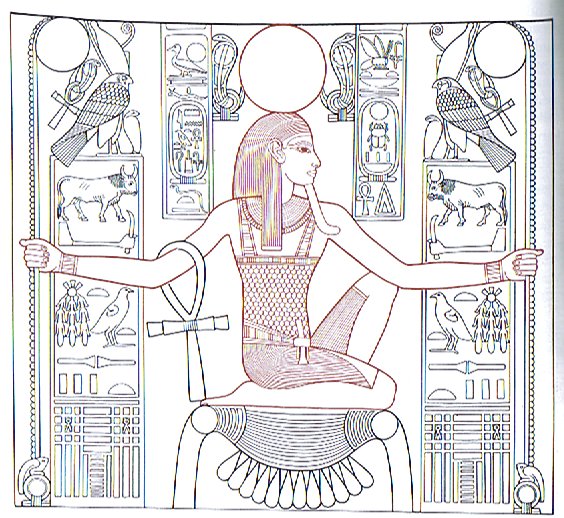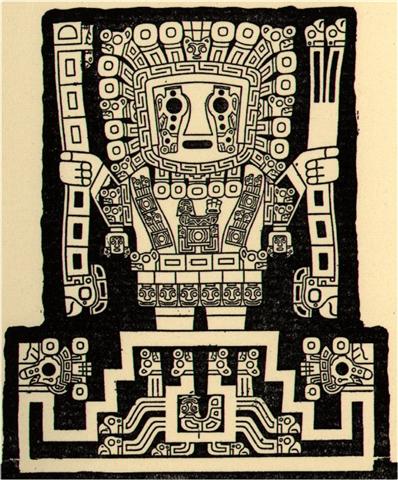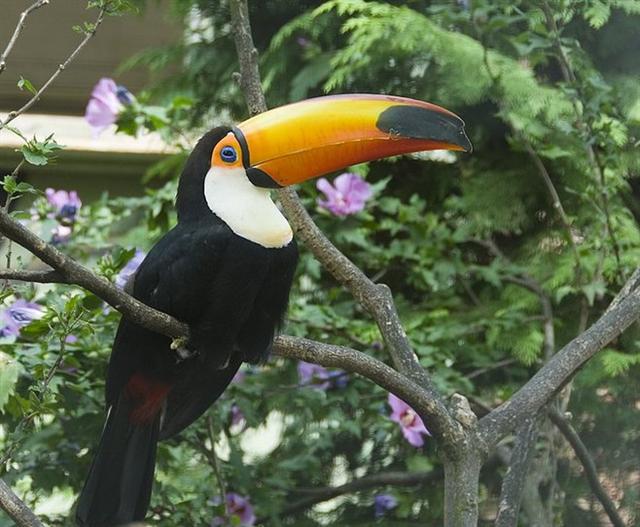212. Obviously the Toad of autumn was the opposite to the Frog of spring, similar to how Raven was the opposite to Crow, we remember. There was plenty of fresh water available in spring but not after the heat of summer. ... There was no water in the village. The lakes and rivers were dry. Raven and Crow, two young girls who were having their first menstrual courses, were told to go and draw water from the ocean. Finding the journey too long, Raven decided just to urinate into her basket-bucket. She decieved no one and was severly scolded. Crow returned much later but with drinking water. As a punishment, Raven was condemned never to find water in the summer; only in winter would she find something to drink. For that reason the Raven never drinks during the hot months; she speaks with a raucous voice because of her dry throat ...
... According to Wilkinson Heh personified eternity: The semantic meaning of the word heh was 'one million' or a very large number. The iconography in the picture therefore seems to tell us heh-em-renput, 'a million years'. The palm branches (renpet) in the picture rest on tadpoles symbolizing 100 000 (meaning fruitfulness, birth, regeneration etc) and the tadpoles are sitting on schen, signs which symbolize eternity ... ... Three hundred and sixty degrees, then as now, represented the circumference of a circle - the cycle of the horizon - while three hundred and sixty days, plus five, marked the measurement of the circle of the year, the cycle of time. The five intercalated days that bring the total to three hundred and sixty-five were taken to represent a sacred opening through which spiritual energy flowed into the round of the temporal universe from the pleroma of eternity, and they were designated, consequently, days of holy feast and festival ... Frogs develop from water and before going up on land they are tadpoles. ... During his descent the ancestor still possessed the quality of a water spirit, and his body, though preserving its human appearance, owing to its being that of a regenerated man, was equipped with four flexible limbs like serpents after the pattern of the arms of the Great Nummo. The ground was rapidly approaching. The ancestor was still standing, his arms in front of him and the hammer and anvil hanging across his limbs. The shock of his final impact on the earth when he came to the end of the rainbow, scattered in a cloud of dust the animals, vegetables and men disposed on the steps. When calm was restored, the smith was still on the roof, standing erect facing towards the north, his tools still in the same position. But in the shock of landing the hammer and the anvil had broken his arms and legs at the level of elbows and knees, which he did not have before. He thus acquired the joints proper to the new human form, which was to spread over the earth and to devote itself to toil ... The Egyptian god of eternity (Heh) was placed in the center between a pair of 'trees' (palm branches) and we can compare with the the composition with the Weeping God in the center between another pair of 'trees' (probably representing 'years' like the Egyptian palm branches, renpet) - although his arms are not outstretched but compressed due to the darkness ruling on the night side (between autumn and spring equinox or between evening and dawn) in the confinement in the womb of Mother Earth. ... They were Ranginui, the Sky Father, and Papatuanuku, the Earth Mother, both sealed together in a close embrace. Crushed between the weight of their bodies were their many children, whose oppression deepened. They yearned to be free; they fought their parents and each other to break loose. Tuumatauenga, virile god of war, thrust and shouted; Tangaroa of the oceans whirled and surged; Tawhirirangimaatea, Haumiatiketike and Rongomatane, of wild foods and cultivated crops, tried their best but were not successful; and Ruamoko, god of earthquakes, yet to be born, struggled in the confinement of his mother's womb ... Of them all, Taane Mahuta, the god of the forests, was the most determined; he set his sturdy feet upon his father's chest, and braced his upper back and shoulders against the bosom of his mother. He pushed; and they parted. So the world, as the Maori understand it, came into being ...
There were 392 days from the beginning of side a (from Ca1-1) to the beginning of side b (to Cb1-1) and 392 could quite well have represented 365 + 27 (the precessional distance down to Roman times):
The figure in Ca1-6 could then represent the completion of a year with 365 days, corresponding to the time when Betelgeuze (*88) had been at 0h, because March 27 (*372 = *6 + *366) - *88 = *284 (30 December) and this date could be observed at the time where the Full Moon reached λ Phoenicis and β Tucanae. In Roman times the corresponding place had been at 'February 28 (31 + 28 = 59 = 2 * 29½).
The glyph numbers on side a will then correspond to number of right ascension days counted from 0h, i.e. those right ascension days which could be observed from the stars close to the Full Moon. And on side b of the tablet the glyph numbers counted from Cb1-1 would correspond to the right ascension day numbers counted from Polaris, i.e. at the time when in Roman times the First Point of Aries had been in day 80. Which means a glyph number on side b as counted from Ca1-1 would be equal to 392 + its glyph number counted from Cb1-1.
|
|||||||||||||||||||||||||||||||||||||||||||||||||||||||||||||||||||||||||||||||||||||||||||||||||||||||||||||||||||||||||||||||||||||||||||||||||||||||||||||||||||||||||||||||||||||||||||||||











